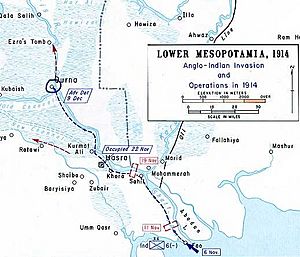Fao Landing facts for kids
Quick facts for kids Fao Landing |
|||||||
|---|---|---|---|---|---|---|---|
| Part of the Mesopotamian Campaign of World War I | |||||||
 Map showing the initial British attack and capture of Basra, 1914. |
|||||||
|
|||||||
| Belligerents | |||||||
| Commanders and leaders | |||||||
| Units involved | |||||||
|
Elements of 38th Division, Iraq Area Command | ||||||
| Casualties and losses | |||||||
| Light, including one officer | 300 captured 135 dead | ||||||
The Fao Landing was an important battle during World War I. It happened between November 6 and November 8, 1914. British soldiers attacked a strong fort called Fao, which belonged to the Ottoman Empire. This attack was the very first step in the Mesopotamian Campaign. The main goal was to keep the British Empire's valuable oil supplies in the Persian Gulf safe. The Ottoman defenders didn't fight much and ran away after heavy bombing.
Why the Fao Landing Happened
When the Ottoman Empire joined World War I, Britain became worried. They feared for the safety of their oil facilities. These important oil sites were located in the Persian Gulf. To protect their oil, the British decided to take control of the Ottoman-held coast.
The Fao Fortress was the main Ottoman fort on the Persian Gulf coast. British commanders thought it was the perfect place for the Ottomans to attack their oil. So, the British planned to capture it first. They sent a group called Indian Expeditionary Force D (IEF D). This force included the 6th (Poona) Division, led by Lieutenant General Arthur Barrett.
The Attack on Fao
The first British soldiers to land were Royal Marines. They came from a ship called HMS Ocean. British Indian troops from the 16th (Poona) Brigade also joined them. This group was led by Walter Sinclair Delamain.
Another British ship, HMS Odin, fired its guns at the Turkish positions. It bombed the enemy's cannons near the old Fao fort. This cleared the way for the landing force. About six hundred soldiers came ashore. The water was shallow and muddy. They brought two mountain guns with them.
The Ottoman soldiers didn't put up much of a fight. The combined British and Indian forces quickly captured the Ottoman positions. They found a lot of equipment that was still in good condition. This included several artillery guns, many still loaded and ready to fire. It seemed the Ottoman soldiers left the fort when their commander was killed by a shell.
What Happened Next
Capturing Fao was a big mistake for the Ottomans. They never truly recovered from losing this important fort. The British continued to defeat them in the following year. The Ottomans no longer controlled a key way into the Persian Gulf. This made British oil facilities much safer.
However, the British felt their oil wouldn't be completely safe until they captured Baghdad. This led to more battles aimed at Baghdad. The British finally captured Baghdad in 1917.

